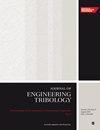Eco-friendly sustainable machining with MoS2-based solid lubricant
IF 1.8
3区 工程技术
Q3 ENGINEERING, MECHANICAL
Proceedings of the Institution of Mechanical Engineers, Part J: Journal of Engineering Tribology
Pub Date : 2023-07-10
DOI:10.1177/13506501231184304
引用次数: 0
Abstract
Machining is one of the basic and inevitable operations in the manufacturing industry. The machining performance is estimated based on various parameters like cutting forces, surface roughness, tool–chip interface temperature, and specific energy. In the traditional approach, cutting fluids are greatly utilized to dissipate the generated heat during machining, but their utilization causes a threat to nature and human being’s health. Therefore, there emerges a necessity to determine user-friendly, sustainable, and eco-friendly substitutes for traditional cutting fluids. The field of advanced tribology has proposed the usage of solid lubricants due to their inherent properties, such as excellent tribological performance, reduced machining zone temperature due to lowered friction, and enhanced tool life. Therefore, in the present study, pure MoS2 and composite MoS2–TiO2 solid lubricants have been employed in the milling process of AISI 52100 steel with HSS end mill cutter. The machining was carried out in different conditions such as uncoated tool without use of lubricant, uncoated tool with use of lubricant, coated tool without use of lubricant, and coated tool with use of lubricant that were employed to analyze their effect on machining performance. The experimental results showed substantial improvement regarding reduced cutting forces, reduced temperature at tool–chip interface, improved surface finish, and average tool wear with the application of solid lubricants. Among the various lubricating conditions, composite MoS2–TiO2-coated tool with composite MoS2–TiO2 lubricant exhibits excellent machining performance.以二硫化钼为基础的固体润滑剂的环保可持续加工
机械加工是制造业中必不可少的基本工序之一。加工性能是根据切削力、表面粗糙度、刀具-切屑界面温度和比能等各种参数来估计的。在传统的加工方法中,大量利用切削液来散热加工过程中产生的热量,但其利用对自然和人类健康造成了威胁。因此,有必要确定传统切削液的用户友好、可持续和环保替代品。先进摩擦学领域已经提出使用固体润滑剂,因为它们具有固有的特性,例如优异的摩擦学性能,由于降低摩擦而降低加工区域温度,并提高刀具寿命。因此,本研究采用纯MoS2和复合MoS2 - tio2固体润滑剂对AISI 52100钢进行HSS立铣刀铣削加工。在无涂层刀具不使用润滑剂、无涂层刀具使用润滑剂、涂层刀具不使用润滑剂、涂层刀具使用润滑剂等不同条件下进行加工,分析其对加工性能的影响。实验结果表明,固体润滑剂在降低切削力、降低刀具-切屑界面温度、改善表面光洁度和平均刀具磨损方面有显著改善。在各种润滑条件下,复合MoS2-TiO2涂层刀具与复合MoS2-TiO2润滑剂表现出优异的加工性能。
本文章由计算机程序翻译,如有差异,请以英文原文为准。
求助全文
约1分钟内获得全文
求助全文
来源期刊

CiteScore
4.20
自引率
5.00%
发文量
110
审稿时长
6.1 months
期刊介绍:
The Journal of Engineering Tribology publishes high-quality, peer-reviewed papers from academia and industry worldwide on the engineering science associated with tribology and its applications.
"I am proud to say that I have been part of the tribology research community for almost 20 years. That community has always seemed to me to be highly active, progressive, and closely knit. The conferences are well attended and are characterised by a warmth and friendliness that transcends national boundaries. I see Part J as being an important part of that community, giving us an outlet to publish and promote our scholarly activities. I very much look forward to my term of office as editor of your Journal. I hope you will continue to submit papers, help out with reviewing, and most importantly to read and talk about the work you will find there." Professor Rob Dwyer-Joyce, Sheffield University, UK
This journal is a member of the Committee on Publication Ethics (COPE).
 求助内容:
求助内容: 应助结果提醒方式:
应助结果提醒方式:


